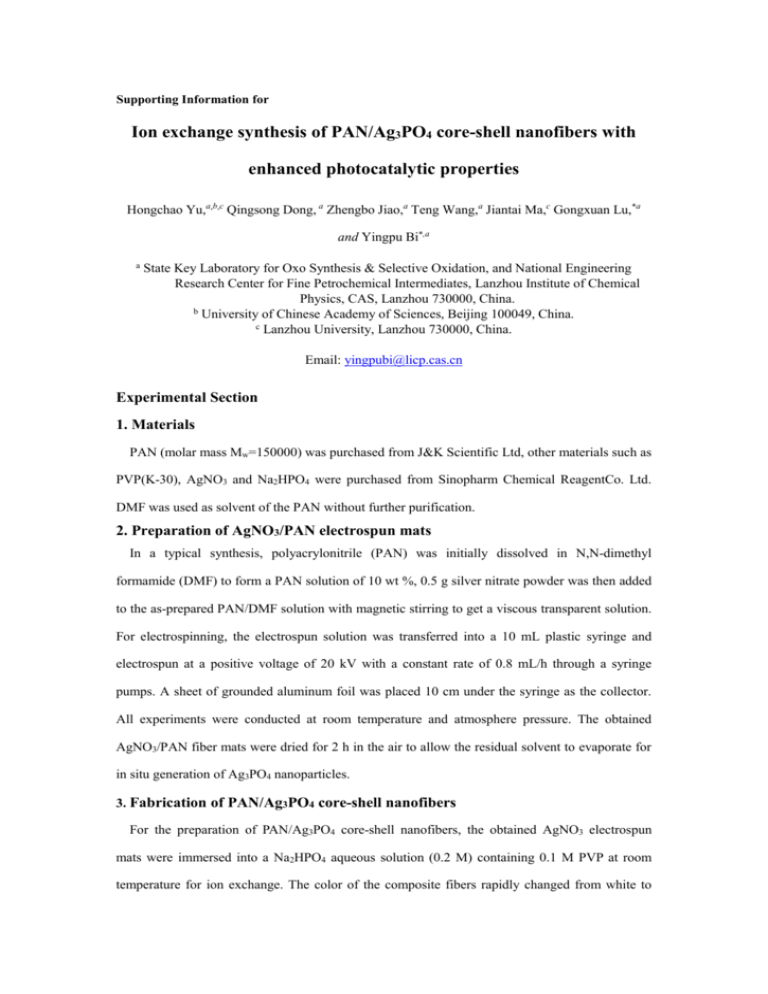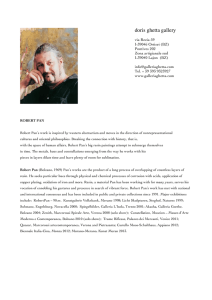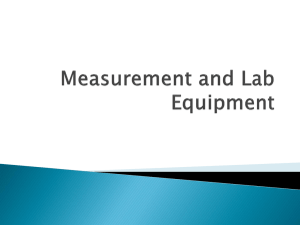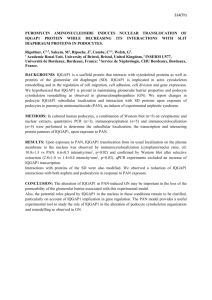Supporting Information for Ion exchange synthesis of PAN/Ag3PO4 c
advertisement

Supporting Information for Ion exchange synthesis of PAN/Ag3PO4 core-shell nanofibers with enhanced photocatalytic properties Hongchao Yu,a,b,c Qingsong Dong, a Zhengbo Jiao,a Teng Wang,a Jiantai Ma,c Gongxuan Lu,*a and Yingpu Bi*,a a State Key Laboratory for Oxo Synthesis & Selective Oxidation, and National Engineering Research Center for Fine Petrochemical Intermediates, Lanzhou Institute of Chemical Physics, CAS, Lanzhou 730000, China. b University of Chinese Academy of Sciences, Beijing 100049, China. c Lanzhou University, Lanzhou 730000, China. Email: yingpubi@licp.cas.cn Experimental Section 1. Materials PAN (molar mass Mw=150000) was purchased from J&K Scientific Ltd, other materials such as PVP(K-30), AgNO3 and Na2HPO4 were purchased from Sinopharm Chemical ReagentCo. Ltd. DMF was used as solvent of the PAN without further purification. 2. Preparation of AgNO3/PAN electrospun mats In a typical synthesis, polyacrylonitrile (PAN) was initially dissolved in N,N-dimethyl formamide (DMF) to form a PAN solution of 10 wt %, 0.5 g silver nitrate powder was then added to the as-prepared PAN/DMF solution with magnetic stirring to get a viscous transparent solution. For electrospinning, the electrospun solution was transferred into a 10 mL plastic syringe and electrospun at a positive voltage of 20 kV with a constant rate of 0.8 mL/h through a syringe pumps. A sheet of grounded aluminum foil was placed 10 cm under the syringe as the collector. All experiments were conducted at room temperature and atmosphere pressure. The obtained AgNO3/PAN fiber mats were dried for 2 h in the air to allow the residual solvent to evaporate for in situ generation of Ag3PO4 nanoparticles. 3. Fabrication of PAN/Ag3PO4 core-shell nanofibers For the preparation of PAN/Ag3PO4 core-shell nanofibers, the obtained AgNO3 electrospun mats were immersed into a Na2HPO4 aqueous solution (0.2 M) containing 0.1 M PVP at room temperature for ion exchange. The color of the composite fibers rapidly changed from white to yellow, thus, Ag3PO4 nanoparticles were synthesized on the surface polymer nanofibers via the reaction of Ag+ with (HPO4)2-. The obtained samples for morphology and structure analysis were washed three times with distilled water to remove the PVP residue and subsequently dried at 60℃ for 1 h. 4. Photocatalytic Reactions In a typical test, the sample (0.6 g, mass ratio of Ag3PO4: PAN was 1:2) was mixed with an aqueous solution of RhB dye (100 mL, 8 mg/L). The reaction system was irradiated with a 300 W Xe arc lamp equipped with an ultraviolet cutoff filter to provide visible light with λ≥420 nm. The degradation of RhB dye was monitored by UV/Vis spectroscopy. Before the spectroscopy measurement, this photocatalyst was removed from the photocatalytic reaction systems by a dialyzer (Millipore, Millex-LH 0.45 μm). 5. Characterizations The morphologies were observed by field-emission scanning electron microscope (FE-SEM, JSM 6701F) operated at an accelerating voltage of 5 kV. The X-ray diffraction (XRD) measurements were performed on X' pert PRO diffractometer using Cu K radiation (40 kV). The XRD patterns were recorded from 10 to 90 with a scanning rate of 0.067/s. The XPS was performed by an ESCALAB 250 Xi XPS system of Thermo Fisher Scientific, England and excited by monochromatic Al Kα radiation (1486.6 eV). The infrared spectra were obtained on a TENSOR27 FT-IR spectrometer using the KBr disk method. UV/vis absorption spectra were taken at room temperature on a UV-2550 (Shimadzu) spectrometer. Additional Figures and Discussions Reasons for using PAN in the photocatalytic system. It has been generally known that electrospinning could serve as a universal and versatile method to generate 1D nanostructure with controlled morphology and composition compared with other fabrication methods. The electrospun nanofibers can further serve as the templates to obtain multifunctional nanostructures by controlling the fiber compositions. Thereby, we expect that the rational design and fabrication of well-defined PAN-Ag3PO4 composite nanofibers may greatly improve the current photochemical reactivity and open up new applications. In the PAN/Ag3PO4 hetero-structures, PAN acted as polymer template to make the Ag3PO4 nanoparticles expose completely and densely on the fiber surface without agglomeration, thus they could share the photo-excited electrons and achieve novel collective photocatalytic properties. Furthermore, it has been widely known that after photocatalytic reaction, the recovery process is very difficult for the conventional powder photocatalysts. However, the PAN-based electrospun nanofibers can be easily separated from solution by filtration or sedimentation due to its hydrophobic property with a low density. Besides, PAN possesses some clear advantages over other polymers, such as its straightforward synthesis, high environmental stability, and good processibility. Fig. S1 Histogram showing the diameter distribution of the PAN/Ag3PO4 core-shell nanofibers, as measured by SEM. (A) Prepared from the Na2HPO4 aqueous solution in the presence of PVP, (B) prepared from the Na2HPO4 aqueous solution in the absence of PVP. Fig. S2 (A, B) SEM images of AgNO3/PAN nanofibers with mass ratio of AgNO3 and PAN 1.5:1; (C, D) SEM images of corresponding PAN/Ag3PO4 core-shell nanofibers Fig. S3 (A, B) TEM images of as-prepared PAN/Ag3PO4 core-shell nanofibers with mass ratio of AgNO3 and PAN 1:1; (C, D) TEM images of PAN/Ag3PO4 composite nanofibers with mass ratio of AgNO3 and PAN 0.25:1 Results and discussion Fig. S3A and S3B show the typical transmission electron microscopy (TEM) images of the as-prepared PAN/Ag3PO4 core-shell nanofibers. It can be clearly seen from Fig. S3A that the surface of the fibers was covered completely and densely by the Ag3PO4 nanoparticles and the nanofibers present a rough surface, corresponding to the observation of the SEM images. To further investigate the structure of PAN fiber nanocores and Ag3PO4 nanoshells, the nanofibers with incompletely covered were obtained via decreasing the content of the AgNO3 in the AgNO3/PAN electrospun mats. As shown in Fig. S3B, it can be clearly seen that the PAN fibers possessed unbroken fibrous structure to form the cores of the composite nanofibers, while the Ag3PO4 nanoparticles resided on the outside surface of the PAN nanofibers to constitute the shells of the fibers. Thereby, we believe that the composite nanofibers with Ag3PO4 nanoparticles completely coated have undoubtedly a core-shell structure. Fig. S4 EDS spectra of the as-synthesized PAN/Ag3PO4 core-shell nanofibers. Fig. S5 FTIR spectra of the a) PAN nanofibers, b) AgNO3/PAN nanofibers, c) PAN/Ag3PO4 core-shell nanofibers FTIR analysis of the as-prepared PAN/Ag3PO4 core-shell nanofibers Fourier transformation infrared spectroscopy (FTIR) analysis was performed in our study in order to investigate the interaction between the polymer and the inorganic phase by comparing the infrared absorption of the composite fibers and pure PAN nanofibers. Fig. S5a shows the typical FTIR spectrum of PAN nanofibers, it can be clearly seen that the PAN displays the characteristic absorption peaks of the CN nitrile group at around 2241 cm-1, besides, a series of characteristic bands in the regions 2930-2870 cm-1, 1460-1450 cm-1, 1380-1360 cm-1 and 1290-1260 cm-1 are ascribed to the vibrations of different modes in methylene group of PAN. As shown in Fig. S5b, a new set of bands are observed due to the presence of AgNO3, including the bands at 1037 cm-1, 818 cm-1, attributed to the N-O stretching vibration and the bending vibration of nitrate, respectively. These peaks are undetectable after the ion exchange reaction (Fig. S5c), on the other hand, significant spectroscopic bands at 980 cm-1 and 818 cm-1 appear which assigned to the P-O stretching vibrations of the PO43-, indicating the formation of the Ag3PO4. Fig. S6 SEM images of the nanoproducts prepared with different compounds: (A) Na2S solution, (B) KBr solution, (C) Na2WO4 solution; (D) their XRD patterns. Results and discussion Here, we extend the approach combining electrospinning and ion exchange reaction to develop a general methodology for generation of other Ag-based core-shell nanostructures using AgNO3/PAN electrospun mats as precursor and template. The morphology of nanoproducts prepared with other compounds has also been investigated. As shown in Fig. S6A, in the case of Na2S aqueous, dense and homogeneous Ag2S nanoparticles reside on the PAN fibers to form PAN/Ag2S core-shell structure. Moreover, when NaBr solution is used in this process, PAN/AgBr core-shell nanofibers are obtained (Fig. S6B), the same goes for Na2WO4 aqueous (Fig. S6C). Their crystalline structures have also been studied, and the XRD results are shown in Fig. S5D. The ultraviolet-visible diffuse reflectance spectra have also been studied and presented in Fig. S7. These demonstrations suggest that the method combining electrospinning with ion exchange reaction can be served as a general and facile synthesis process for the generation of polymer/ inorganic composites with core-shell structures. Fig. S7 The ultraviolet-visible diffusive absorption spectrums of different core-shell hetero-structures: PAN/Ag2S core-shell nanofibers, PAN/AgBr core-shell nanofibers and PAN/Ag2WO4 core-shell nanofibers. Fig. S8 The intensity and wavelength distribution of the irradiation light employed in the organic decomposition experiments. Integral intensities were measured under the actual experimental conditions. Fig. S9 (A, C) SEM images of the Ag3PO4 nanoparticlesⅠandⅡ; (B, D) their XRD patterns. Preparation of Ag3PO4 nanoparticlesⅠandⅡ Ag3PO4 nanoparticlesⅠwas synthesized by precipitation of AgNO3 and H3PO4 in the presence of oleylamine according to the method mentioned in previous literature[1]. Ag3PO4 nanoparticles Ⅱ was fabricated by a new method we are studying now. Fig. S9 show the SEM images of the products, indicating that both the samples with the average diameter of 65 nm, nearly the same as Ag3PO4 nanoparticles resided on the PAN fibers. From their XRD patterns, it can be clearly seen that all the diffraction peaks of the products could be perfectly indexed to the body-centered cubic structure of Ag3PO4 (JCPDS no 06-0505). Reference [1]. C. T. Dinh, T. D. Nguyen, F. Kleitz and T. O. Do, ChemComm., 2011, 47, 7797. Fig. S10 The ultraviolet–visible diffusive reflectance spectrums of N-doped TiO2. Fig. S11 Photocatalytic activities of PAN/Ag3PO4 core-shell nanofibers for the degradation of (A) MB and (B) MO dye under visible light irradiation (λ>420 nm) at room temperature. Fig. S12 Photocatalytic activities of the PAN/Ag3PO4 core-shell nanofibers for the degradation of RhB under visible light irradiation (λ>420 nm) for five cycles. Fig. S13 Photocatalytic activities of the Ag3PO4/PAN Necklace-like nanofibers for the degradation of RhB under visible light irradiation (λ>420 nm) for three cycles.







